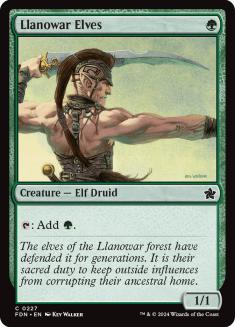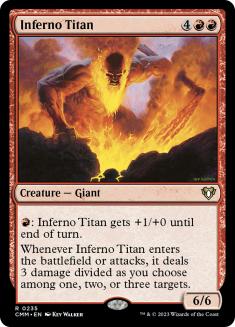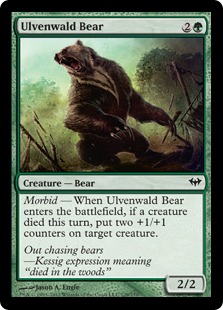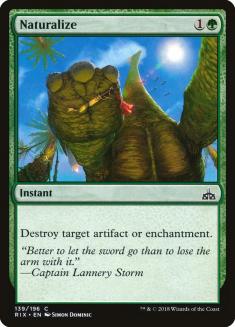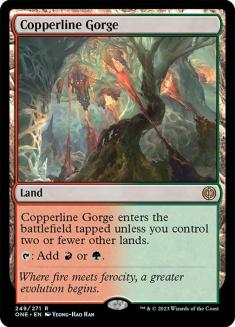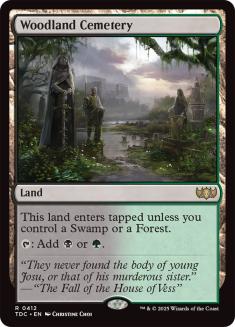Green toolbox decks aren’t anything new. In fact, green mages basically invented the archetype. Vampiric Tutor was around first, but that tended to lend its hand towards degenerate decks and tighter silver bullet packages. Survival of the Fittest was and still is the king of all toolboxes.
Creatures (21)
- 4 Birds of Paradise
- 1 Anger
- 1 Eternal Witness
- 1 Bone Shredder
- 1 Loyal Retainers
- 1 Wall of Roots
- 1 Squee, Goblin Nabob
- 2 Mesmeric Fiend
- 1 Harmonic Sliver
- 1 Big Game Hunter
- 1 Magus of the Moon
- 1 Iona, Shield of Emeria
- 1 Emrakul, the Aeons Torn
- 4 Fauna Shaman
Lands (23)
Spells (16)

This was probably the last traditional list of the deck before Survival mutated into the combo engine it’s currently remembered as. Still, even without playing a game, you can feel something is different from the recent Tutor-based lists.
Creatures (26)
- 1 Llanowar Elves
- 4 Birds of Paradise
- 2 Acidic Slime
- 4 Lotus Cobra
- 1 Cunning Sparkmage
- 3 Sea Gate Oracle
- 2 Vengevine
- 2 Inferno Titan
- 1 Obstinate Baloth
- 1 Sylvan Ranger
- 1 Sylvok Replica
- 1 Hero of Oxid Ridge
- 1 Urabrask the Hidden
- 1 Phyrexian Metamorph
- 1 Phantasmal Image
Lands (22)
Spells (12)

Step forward a year and you can see the same plans in motion for a different format. Your engine gets humming, in this case Birthing Pod, and you start churning out an increasing advantage on board and in card quantity. Without Jace, the Mind Sculptor, the Caw-Blade decks of the era couldn’t keep up with the steady stream of cards.
Creatures (27)
- 2 Solemn Simulacrum
- 4 Birds of Paradise
- 1 Archon of Justice
- 2 Acidic Slime
- 1 Frost Titan
- 1 Sun Titan
- 1 Wurmcoil Engine
- 1 Thrun, the Last Troll
- 3 Viridian Emissary
- 1 Elesh Norn, Grand Cenobite
- 1 Phyrexian Metamorph
- 2 Blade Splicer
- 1 Stonehorn Dignitary
- 2 Phantasmal Image
- 1 Fiend Hunter
- 1 Skaab Ruinator
- 2 Avacyn's Pilgrim
Planeswalkers (2)
Lands (22)
Spells (9)

Then rotation happened. Pod fell to the background, and its Tutoring compatriot Green Sun’s Zenith was relegated to the role of Worldly Tutor for Primeval Titan. People tried to innovate the archetype and had at best minimal success. Some key component was missing.
So with Birthing Pod and Green Sun’s Zenith showing up in full power across the three major Constructed formats, what’s going on with their toolboxes?
Creatures (28)
- 1 Solemn Simulacrum
- 4 Birds of Paradise
- 1 Archon of Justice
- 1 Acidic Slime
- 1 Inferno Titan
- 1 Sun Titan
- 1 Wurmcoil Engine
- 1 Viridian Emissary
- 1 Elesh Norn, Grand Cenobite
- 1 Phyrexian Metamorph
- 3 Blade Splicer
- 1 Fiend Hunter
- 2 Avacyn's Pilgrim
- 1 Geist-Honored Monk
- 1 Daybreak Ranger
- 3 Strangleroot Geist
- 4 Huntmaster of the Fells
Lands (24)
Spells (8)

Creatures (22)
- 4 Mother of Runes
- 1 Birds of Paradise
- 1 Scryb Ranger
- 1 Aven Mindcensor
- 1 Gaddock Teeg
- 3 Noble Hierarch
- 4 Knight of the Reliquary
- 2 Qasali Pridemage
- 3 Stoneforge Mystic
- 2 Scavenging Ooze
Planeswalkers (1)
Lands (24)
Spells (13)

What we see here is a fundamental shift. It might not be obvious at first, but allow me to elaborate.
Step 1: The Shift from Single Card Strategies to a Fluid Deck
The Survival of the Fittest decks, no matter whether they were the original Recurring Nightmare lists or the later Vengevine or Necrotic Ooze combo decks, were always a Survival deck. They played the card and went wild or scrapped together some value and tried to beat you down with some Grey Ogres. Late stage lists were even running Enlightened Tutor because having Survival on turn 2 mattered just that much.
The RUG Pod deck from last year’s Standard was much of the same. Six cantrips to find the namesake card, and if it wasn’t there your plan was slightly disjoint. Sea Gate Oracle serving up the beats alongside Vengevine just felt off, as did22 lands with Lotus Cobra. That’s not to say your other cards weren’t good enough to get there, but they weren’t a plan on their own. You weren’t necessarily saddled with a ton of bad cards, but they didn’t fight towards a single end goal without Pod to tie the deck together.
Sound like any other recent deck? Just writing this I’m having flashbacks to Standard Tempered Steel and Modern Robots. If you have the Tempered Steel or Cranial Plating, your deck operates on a completely different level from the competition. The games you don’t you’re often looking your hand and wondering how you are going to MacGyver your way to a win.
Prior to Dark Ascension, the Pod decks in Standard didn’t even look like they had a backup plan. Sea Gate Oracle at least looked serviceable without help. Stonehorn Dignitary? What’s this, a draft deck gone wrong? There aren’t even that many creatures I want to copy with Phantasmal Image in these lists, let alone in my opponent’s decks of the era.
(That actually might be a little harsh. If the last two years of Standard have taught us anything, if you have a Titan in your deck you have a legitimate plan of slamming it and assuming you’ve done enough work to earn a win.)
Now take a look at Max Tietze Naya Birthing Pod deck. What other deck does it immediately draw comparisons to?
Creatures (24)
- 4 Llanowar Elves
- 4 Birds of Paradise
- 1 Acidic Slime
- 1 Glissa, the Traitor
- 1 Thrun, the Last Troll
- 3 Phyrexian Metamorph
- 2 Daybreak Ranger
- 4 Strangleroot Geist
- 4 Huntmaster of the Fells
Lands (24)
Spells (12)

When you don’t have a Birthing Pod, the deck now has a real plan: attack.
The real reason Strangleroot Geist revolutionized the archetype has only a little to do with how it interacts with Pod. If you have an active Pod you should be winning handily anyways. What Strangleroot Geist does is let you win the game when the cards you draw don’t tap to Tutor. Blade Splicer and Huntmaster of the Fells continue the curve of high power, removal resilient bodies that just happen to also make Pod that much better.
Looking to Legacy, we can see Maverick was a deck before Green Sun’s Zenith. It may have not been nearly as prevalent, but between it and its sister deck Death and Taxes most Legacy players were very aware of what the deck was doing. When you don’t have Zenith, what’s your deck doing? Only playing the best green creatures of all time and throwing in some Stoneforge Mystics. If you showed up to an event and forgot your Green Sun’s Zeniths, your Maverick deck would still be reasonably functional.Â
Step 2: Minimizing Dead Slots
So if aggressive Pod decks are so good, why did this deck turn out to not be absolutely exceptional?
Creatures (25)
- 2 Llanowar Elves
- 4 Birds of Paradise
- 1 Inferno Titan
- 1 Sylvok Replica
- 1 Glissa, the Traitor
- 1 Blisterstick Shaman
- 3 Viridian Emissary
- 1 Phyrexian Metamorph
- 1 Chandra's Phoenix
- 1 Stingerfling Spider
- 4 Strangleroot Geist
- 2 Huntmaster of the Fells
- 1 Hellrider
- 1 Vorapede
- 1 Ulvenwald Bear
Lands (23)
Spells (12)
Sideboard

To answer this, let’s steal a trick out of Luis’s book and serve up a sample hand.
Wait, what? This isn’t what I signed up for. Ulvenwald Bears? Blisterstick Shamans? When do I want to draw those cards in Constructed? The answer usually is never, but when you have Pod in play you can set them up to be amazing.
Of course, we can find the issue here. I just spelled it out under a page ago:
“If you have an active Pod you should be winning handily anyways.”
You want your cards to do something when drawn. At an even lower level than them being cohesive, take a look at the card and ask yourself if you would be honestly embarrassed to cast the card. No Stonehorn Dignitaries allowed, and definitely no Stingerfling Spiders.
Looking at Max’s list, I see a grand total of one card I wouldn’t really want to draw: Archon of Justice. Elesh Norn, Grand Cenobite is definitely getting up there, but having played with Frites I can assure you seven mana is definitely in range of a deck with mana dorks.
Aside: This all said if the mana could work for it, I’d definitely be trying to jam a Hellrider into the Naya list. I know we’ve all seen Hero of Oxid Ridge, but the devil is in the details. A world that isn’t flooded with Squadron Hawks and Timely Reinforcements means that Hellrider is forcing through a bunch more damage than its Mirran counterpart.
Looking at Legacy, we have a format that’s probably even more unforgiving of drawing blanks than Standard. The Stoneblade decks are completely attrition based, and coming up one threat short often means the difference between rapidly pulling ahead and being stopped cold. Against other fair decks, your Tutor packages only have four cards you might not want to see: Scryb Ranger, Dryad Arbor, Maze of Ith, and Gaddock Teeg. Even when you do draw them these cards are often respectable. Ranger can carry through equipment in the air or double up on a Mother of Runes to further the soft lock, while Gaddock Teeg shuts off the Stoneblade deck’s access to their big trump of Jace. On the land side, Maze is actually a fair mirror-specific trump. Dryad Arbor is the one purely bad card to draw, and even then you just drew a slightly worse land in exchange for having eight one-drop accelerators all the other games you play.
Step 3: Understanding the Exceptions to the Rules
Creatures (28)
- 4 Birds of Paradise
- 1 Eternal Witness
- 4 Wall of Roots
- 1 Harmonic Sliver
- 1 Reveillark
- 4 Kitchen Finks
- 1 Murderous Redcap
- 1 Ranger of Eos
- 1 Noble Hierarch
- 1 Linvala, Keeper of Silence
- 3 Viscera Seer
- 1 Phyrexian Metamorph
- 1 Entomber Exarch
- 3 Melira, Sylvok Outcast
- 1 Mikaeus, the Unhallowed
Lands (23)
Spells (9)

I’ve largely ignored Cuneo’s Melira deck in this discussion, and on the surface it looks like I should have good reason. It’s everything you would expect from a traditional toolbox deck, with eight fairly situational singletons taking up space.
How is it that this deck has succeeded with this model while all the others have failed?
To be general, the rules don’t apply here. In the context of Melira, card advantage is almost irrelevant. Your non-Tutor gameplan is an infinite combo.
In Standard when you don’t draw Pod, you’re still scrapping your way to a victory. Drawing that second Huntmaster means a lot when the first one has to do work over multiple turns. With Melira, if the combo falls onto the table the game ends. Sacrifice Kitchen Finks to Viscera Seer, it comes back without a -1/-1 counter because of Melira, rinse and repeat. Not only do you gain infinite life, but you get to set up a pseudo-Vampiric Tutor with infinite Viscera Seers leading to a win the next turn via infinite Murderous Redcap triggers. There aren’t any extra turns in the game for it to matter that your last card was Harmonic Sliver instead of a live draw.
What matters is that you have the out against the decks that have some way to interact with your combo or race. When your million life is going to be trumped by a billion 1/4 Clerics, you want a Linvala to shut off their Splinter Twins and Kiki-Jiki, Mirror Breakers.
Looking at Legacy and older Tutor lists, we can see the same principle being applied. Suddenly Pat’s first Columbus deck doesn’t look so much like a random value deck. You have removal for their hate bears, discard, and your choice of which monster to sneak into play. Without Survival making an Emrakul, the Aeons Torn takes a few too many turns of Fauna Shaman activations, but we can see this interaction still alive and kicking in Adam Cai’s Legacy Open winning list.
Creatures (26)
- 4 Mother of Runes
- 1 Loyal Retainers
- 1 Scryb Ranger
- 1 Aven Mindcensor
- 1 Gaddock Teeg
- 4 Noble Hierarch
- 4 Knight of the Reliquary
- 2 Qasali Pridemage
- 3 Fauna Shaman
- 1 Elesh Norn, Grand Cenobite
- 2 Scavenging Ooze
- 2 Thalia, Guardian of Thraben
Planeswalkers (1)
Lands (24)
Spells (10)

Of course there’s no Iona, Shield of Emeria to be seen, but who wants to draw that one? If it was just a Thalia, Guardian of Thraben it would do a lot of the same work even as a Tutor target. On the other hand, Elesh Norn is a unique effect and easily castable off a Knight activation for a Gaea’s Cradle.
Creating a slot-optimized toolbox as opposed to having a laundry list of silver bullets only matters if you’re trying to win via accumulating marginal advantages or need to beat people trying to do so. If you’re just trying to overpower your opponent, you want the best way to end each game.
Green Sun’s Zenith and Birthing Pod are powerful staples that will be here for years to come. Both can be used for near endless configurations, but it’s hard to narrow down what’s actually necessary and what’s just a cool trick you don’t need. Keep these principles in mind, and it should make future templating easier and save time in deck development.
A Follow-up on Last Week:
It appears the return towards purer linear decks has already started in Modern. I didn’t include this deck last week as it was still brand new and there wasn’t a list available, but things have rapidly changed.
Creatures (2)
Planeswalkers (4)
Lands (18)
Spells (36)
- 4 Mindslaver
- 4 Talisman of Impulse
- 4 Sylvan Scrying
- 4 Chromatic Sphere
- 4 Chromatic Star
- 4 Expedition Map
- 3 Explore
- 1 All Is Dust
- 4 Ancient Stirrings
- 4 Prophetic Prism
Sideboard

In under a week this deck, popularized by Pro Tour and US National Champion Charles Gindy, has already redefined the format. It went from zero presence to two PTQ wins in under ten days.
What we have here is a complete linearization of the Tron decks. You have one interactive card in the main. Every game you’re trying to slam a turn 3 or 4 Karn Liberated, which is presumably enough when followed up with a Mindslaver. Yes, that is an Academy Ruins solely activated off Chromatic Spheres and Prophetic Prisms. You aren’t trying to lock them most of the time; it’s just something that can incidentally happen.
This deck is absolutely savage against a lot of what was rising to the top before it showed up. Tron mirrors are a joke as you assemble much faster than they do. Karn is probably the best trump in the mirror, and you have four to their one or zero. You also outrace Melira and easily win through infinite life and have all of Tron’s strengths against traditional blue decks.
So, for those of us who have one last shot before the season ends, how do you keep up with this new competitor?
The first thing is just play a better linear deck. Storm, despite being a little soft to a turn 3 Karn, is still fine. Splinter Twin is also very good against this deck between the fast clock, Remands, and the ability to generate Time Walks with Deceiver Exarch Twiddles. Just keeping them off seven mana for a turn is often enough to change the race in your favor.
The deck I’ve actually had the most success against this newcomer with is Burn.
Creatures (11)
Lands (20)
Spells (29)
- 3 Flames of the Blood Hand
- 4 Lightning Bolt
- 4 Lava Spike
- 4 Magma Jet
- 4 Rift Bolt
- 4 Shard Volley
- 2 Burst Lightning
- 4 Bump in the Night
Sideboard

There are mono-red lists of this floating around that are absolutely unbeatable in the mirror, but I think the mono-Lava Spike plan just has a better flow to it in game and gives you higher odds of ripping out in endgame scenarios.
Everything just lines up perfectly for Burn to beat this new Tron deck. Karn is for the most part irrelevant, they have no way to stop a turn 1 Goblin Guide, and Mindslaver is about a turn too slow to matter. Oftentimes you can just dump most of your hand before Mindslaver hits and just draw a Bolt the next turn for the win. I’ve actually won a game after being Slavered three times with a Karn in play just because I eventually had a single turn and won the coin flip of drawing any burn spell.
Of course, Burn isn’t for everyone. You’re going to lose to your fair share of Lightning Helixes and Obstinate Baloths. What about for the people who just want to play a fair game of Magic and not lose to an opponent having seven mana on turn 3?
If you look at Gindy’s deck, you can see it’s relatively threat-light. A combination of Thoughtseizes or just straight up Negates is probably enough to force them into finding Eye of Ugin to Emrakul you on turn 7 or 8. If you put up a real clock in the form of Delver of Secrets, you should be able to finish them before then. A counter-heavy version of the W/U/R Delver deck would be a good place to be against this deck. The other angle I would consider is a Faeries list. If you can just make the game last that long, Cryptic Command covers the normal threats and lets you hold off an Emrakul while Mistbind Clique is just a free turn and huge threat. Vendilion Clique not only lands a solid clock but attacks their threats. I’m sure that post-board you could easily make a Faeries deck that beats this build of Tron.
I don’t expect this deck’s metagame saturation to hold forever, but if you’re playing Modern at the tail end of this season you need to be aware of it. If you can’t beat R/G Tron, consider why you aren’t. For a paper event it might be realistic to assume the deck won’t be all over the place due to deck choice inflexibility, but on Magic Online you need to be ready.

